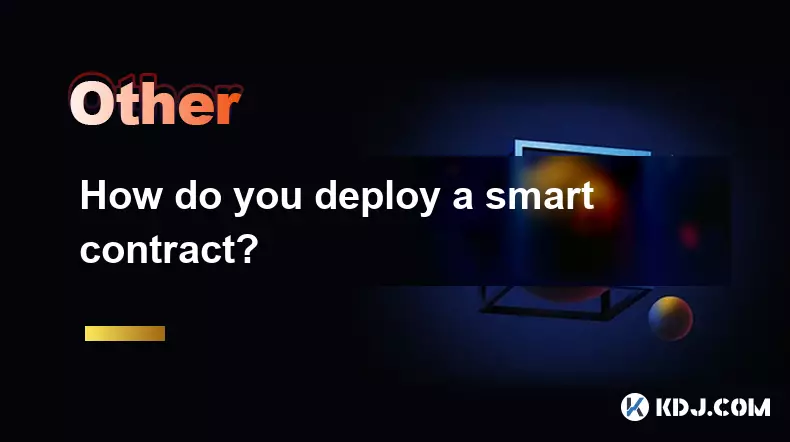-
 bitcoin
bitcoin $99296.318777 USD
-2.82% -
 ethereum
ethereum $3203.465899 USD
-6.84% -
 tether
tether $0.999590 USD
-0.03% -
 xrp
xrp $2.308913 USD
-4.00% -
 bnb
bnb $922.788929 USD
-3.53% -
 solana
solana $144.020807 USD
-5.89% -
 usd-coin
usd-coin $0.999798 USD
0.00% -
 tron
tron $0.291590 USD
-1.12% -
 dogecoin
dogecoin $0.163780 USD
-4.46% -
 cardano
cardano $0.526919 USD
-4.40% -
 hyperliquid
hyperliquid $37.888865 USD
-2.24% -
 bitcoin-cash
bitcoin-cash $510.515457 USD
-1.08% -
 chainlink
chainlink $14.436987 USD
-5.63% -
 stellar
stellar $0.267345 USD
-4.77% -
 unus-sed-leo
unus-sed-leo $9.175222 USD
0.53%
How do you deploy a smart contract?
Deploying a smart contract involves writing, testing, and compiling code, then sending it as a transaction to the blockchain, where it becomes immutable and runs on the EVM after deployment.
Sep 03, 2025 at 01:54 pm

Understanding Smart Contract Deployment
Deploying a smart contract involves uploading its code to a blockchain network where it becomes immutable and executable. This process requires several preparatory steps, including writing, testing, and compiling the contract. Once the code is ready, it is sent as a transaction to the blockchain, consuming gas fees paid in the network’s native cryptocurrency. After confirmation, the contract receives a unique address and becomes active on the chain.
Key Steps in Deploying a Smart Contract
- Write the smart contract using a language compatible with the target blockchain—Solidity is commonly used for Ethereum-based networks.
- Compile the contract using tools like Remix IDE, Hardhat, or Truffle to convert the high-level code into bytecode readable by the Ethereum Virtual Machine (EVM).
- Set up a development environment with a local blockchain such as Hardhat Network or Ganache for initial testing.
- Deploy the contract to the testnet (e.g., Sepolia or Mumbai) to verify functionality without spending real funds.
- Connect to a mainnet using a wallet like MetaMask and a node provider such as Alchemy or Infura to initiate the final deployment transaction.
Tools and Frameworks for Deployment
- Hardhat offers a comprehensive environment for compiling, testing, and deploying contracts with built-in scripting capabilities.
- Truffle provides a suite of tools for smart contract management, including network configuration and automated contract deployment scripts.
- Remix IDE is a browser-based platform ideal for beginners, allowing direct compilation and deployment through a simple interface.
- Ethers.js and Web3.js are JavaScript libraries used to interact with the blockchain programmatically during deployment.
- Foundry enables fast contract testing and deployment using Solidity-based scripts and efficient command-line tools.
Gas Considerations and Security Checks
- Gas fees fluctuate based on network congestion; monitoring current rates helps optimize deployment timing.
- Optimize contract code to reduce complexity and lower gas consumption during deployment and execution.
- Verify the contract source code on explorers like Etherscan to enhance transparency and trust among users.
- Conduct audits using tools like Slither or manual review to detect vulnerabilities such as reentrancy or overflow issues.
- Use OpenZeppelin libraries for standardized, secure implementations of common functionalities like ownership and access control.
Frequently Asked Questions
What happens if a smart contract fails during deployment?If a deployment transaction fails due to out-of-gas or a revert, the transaction is reverted, and the gas used is consumed. The contract address will not be created, and the code will not exist on-chain.
Can a deployed smart contract be upgraded?Most smart contracts are immutable by design. However, upgradeable contracts can be implemented using proxy patterns like Transparent Proxies or UUPS, where logic and data storage are separated.
Do I need to pay to deploy a contract on a testnet?No real funds are required. Testnets use free test tokens distributed through faucets. These tokens have no monetary value but simulate the deployment process accurately.
How do I interact with a deployed smart contract?Using the contract's ABI and its on-chain address, you can connect via web3 libraries like Ethers.js or interact through wallets and dApp interfaces that support contract calls.
Disclaimer:info@kdj.com
The information provided is not trading advice. kdj.com does not assume any responsibility for any investments made based on the information provided in this article. Cryptocurrencies are highly volatile and it is highly recommended that you invest with caution after thorough research!
If you believe that the content used on this website infringes your copyright, please contact us immediately (info@kdj.com) and we will delete it promptly.
- Mohammed Siraj's First Spell Woes: An India Teammate's Critique
- 2025-11-14 14:40:02
- BTC, ETH, and Altcoin Picks: Navigating the Crypto Landscape
- 2025-11-14 14:50:01
- Coin Toss Tales: Temba Bavuma's Wager and India vs. SA Showdown
- 2025-11-14 12:50:01
- Shubman Gill, WTC Final, and the Coin Toss: A New Yorker's Take
- 2025-11-14 15:05:01
- Aerodrome Takes Flight: Unifying Ethereum DeFi Liquidity Across Chains
- 2025-11-14 15:10:02
- Canary XRP ETF and Solana ETF: First-Day Activity Heats Up the Crypto ETF Race
- 2025-11-14 12:20:01
Related knowledge

How does a blockchain handle data storage?
Nov 14,2025 at 04:40pm
Understanding Blockchain Data Structure1. A blockchain stores data in sequential blocks, each containing a list of transactions or records. These bloc...

What are the risks of investing in blockchain projects?
Nov 14,2025 at 10:19am
Risks Associated with Volatility in Cryptocurrency Markets1. The price of digital assets can shift dramatically within minutes due to speculation, new...

What are the most common misconceptions about blockchain?
Nov 14,2025 at 04:19pm
Blockchain is Only About Cryptocurrency1. Many people equate blockchain solely with Bitcoin or other digital currencies, failing to recognize its broa...

How does blockchain enable decentralized finance (DeFi)?
Nov 14,2025 at 07:59am
Understanding the Role of Blockchain in DeFi Infrastructure1. Blockchain serves as the foundational layer for decentralized finance by offering a dist...

What are gas fees on the Ethereum blockchain?
Nov 14,2025 at 09:00am
Understanding Gas Fees on the Ethereum Network1. Gas fees are payments made by users to compensate for the computational energy required to process an...

What are the main advantages of using blockchain technology?
Nov 14,2025 at 08:40am
Enhanced Security and Data Integrity1. Blockchain uses cryptographic hashing to secure each block, making it nearly impossible to alter data without d...

How does a blockchain handle data storage?
Nov 14,2025 at 04:40pm
Understanding Blockchain Data Structure1. A blockchain stores data in sequential blocks, each containing a list of transactions or records. These bloc...

What are the risks of investing in blockchain projects?
Nov 14,2025 at 10:19am
Risks Associated with Volatility in Cryptocurrency Markets1. The price of digital assets can shift dramatically within minutes due to speculation, new...

What are the most common misconceptions about blockchain?
Nov 14,2025 at 04:19pm
Blockchain is Only About Cryptocurrency1. Many people equate blockchain solely with Bitcoin or other digital currencies, failing to recognize its broa...

How does blockchain enable decentralized finance (DeFi)?
Nov 14,2025 at 07:59am
Understanding the Role of Blockchain in DeFi Infrastructure1. Blockchain serves as the foundational layer for decentralized finance by offering a dist...

What are gas fees on the Ethereum blockchain?
Nov 14,2025 at 09:00am
Understanding Gas Fees on the Ethereum Network1. Gas fees are payments made by users to compensate for the computational energy required to process an...

What are the main advantages of using blockchain technology?
Nov 14,2025 at 08:40am
Enhanced Security and Data Integrity1. Blockchain uses cryptographic hashing to secure each block, making it nearly impossible to alter data without d...
See all articles










































































